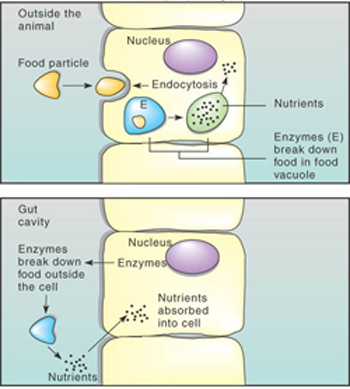
Intracellular (top) and Extracellular Digestion (bottom)
Intracellular
vs. Extracellular Digestion
Some
of the simplest forms of life (protists and sponges) have no gut and thus carry
out intracellular digestion. Tiny food
particles are taken into the cell directly from the environment by diffusion or
endocytosis.
Digestion begins in a food vacuole where lysosomal
enzymes break the small particles into constituent nutrients. Intracellular digestion eliminates the need
for a gut or other cavity in which to chemically digest food. At the same time, however, intracellular
digestion limits an animal’s size and complexity—only very small pieces of food
can be used.
Larger
animals have evolved structures and mechanisms for extracellular
digestion, the enzymatic breakdown of larger pieces of food in a special organ
or cavity. Cells lining the gut cavity
secrete enzymes into the cavity. There,
the enzymes break down food materials into constituent nutrients, and the
nearby cells absorb these nutrients.
 |
Intracellular (top) and Extracellular Digestion (bottom) |